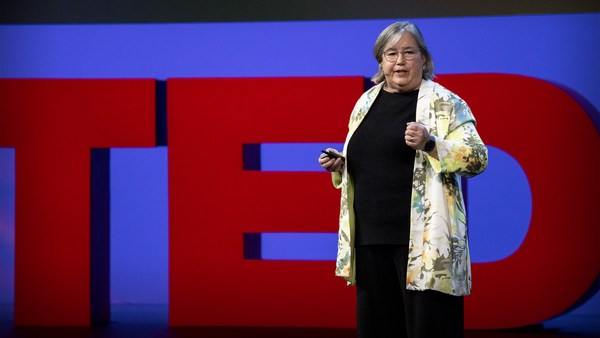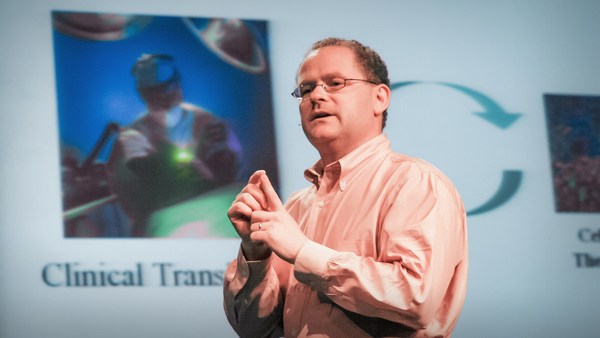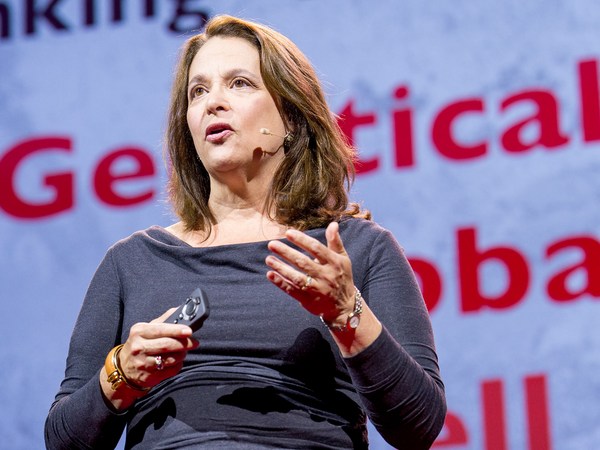I'd like to begin by telling you a story. It's a short story about a special family. In 1960, a Utah man by the name of Roscoe Nelson, a father of six, died suddenly of unknown cause. He was 43 years old. As a surgeon himself, Dr. Nelson knew that his progressive kidney failure would ultimately take his life. But he was in the dark as to the cause, and he had no access to treatment.
Within two decades, tragedy struck again when four of Roscoe's six children also developed kidney failure. Looking back as far back as the 1800s, every generation in this family has been struck down at a young age by a mysterious and vicious disease. What could be the cause?
Fast forward to 2013. A team of brilliant geneticists identified the cause of Roscoe Nelson's deadly disease. It was a mutation, a single extra letter in the DNA, hiding in a dark corner of a gene called MUC1. The mutation had been passed down from generation to generation, leading to early deaths from kidney failure. The discovery of this mutation ended a decades-long diagnostic odyssey for this family and many families like them.
Now, as a physician-scientist and cell biologist at Harvard, I have learned that studying this disease and genetic diseases like it is not only important to the families they so tragically affect. This work is a critical scientific and research priority for all of us. Why? Because what my team and I uncovered by studying this seemingly obscure disease is a series of portals into the inner workings of human cells, gaining unexpected insights into fundamental biology. And best of all, we uncovered incredible opportunities for the treatment of not one but many dozens of diseases.
You see, the amazing thing about science, the reason I love what I do is that if you follow your curiosity, it can lead to untold scientific treasures. So in essence, my big idea for you today is ... sleuthing. Not the kind that solves crimes, but the kind that solves scientific mysteries, what I call molecular sleuthing or what is otherwise known as hypothesis-driven science or curiosity-driven science.
It is an idea as old as Aristotle, who was born more than 2,400 years ago, not far actually from where I was born and raised, in Thessaloniki, Greece. Aristotle taught that at the foundation of any scientific pursuit is formulating a hypothesis, asking a question that can be tested experimentally. Sleuthing of this nature is central to the scientific method and has led humans to amazing discoveries.
So how did molecular sleuthing help us unlock the secrets of the vicious mutation that killed Roscoe Nelson? Well, once the mutation was uncovered, the next question was how can a single extra letter in the DNA lead to so much trouble? My team and I got to work, using classical hypothesis-driven science, but with a twist. Our molecular detective work is now supercharged by our ability to use modern, scalable tools and technologies. Let me explain.
To understand how a single extra letter in the DNA can lead to disease, I must first remind you of some basic biology. In nearly every cell in our bodies, the three billion letters of genetic information, the DNA, is transcribed into RNA and in turn, RNA churns out proteins, which are the business end of what our cells use to perform their basic functions. The engine that turns DNA to RNA to proteins works tirelessly in each of 37 trillion cells in our bodies. So normally the MUC1 gene churns out a protein called mucin 1, which goes to the surface of cells and forms a protective blanket around them. We hypothesized that the mutation in the MUC1 gene is generating a mucin 1 protein that is not doing what it is supposed to do. How could we test this hypothesis?
A couple of decades ago, when I was a student, this type of work would have involved just a handful of petri dishes at a time. This meant that in a day’s work, I could really only test five or six different experimental conditions to see how the cells responded. And then I had to spend several long days at the microscope, taking images one by one, analyzing them one by one, to finally make sense of the data. Instead, my students at Harvard and MIT have access to state-of-the-art computer-controlled robotic systems and microscopes and artificial intelligence-powered software, which enable them to analyze thousands of images, all in a day's work. As such, we can study cells grown in special dishes that allow us to test hundreds of experimental conditions at a time. In fact, I estimate that our molecular sleuthing to date has generated more than 50 million images containing information derived from more than 100 billion cells. That's as many cells as there are stars in the Milky Way. And in the end, the vicious mutation that killed Roscoe Nelson revealed its secrets.
Remember, we hypothesized that the mutation in the MUC-1 gene is generating a mucin 1 protein that is not doing what it is supposed to do. Normally mucin 1 goes to the surface of cells. However, we found that the mutation in the MUC-1 gene is generating a mangled, misshapen mutant protein that does not go to the surface of cells, but instead accumulates inside. This led to a new hypothesis. Is the mutant protein getting trapped inside cells, and how does this happen?
After some more molecular sleuthing, we learned that the misshapen protein accumulates inside cells because of another molecule, a so-called cargo receptor. Thinking they're being helpful, these cargo receptors grab the mangled proteins and throw them on board like cargo trucks carrying a growing heap of nasty trash with nowhere to go. Unable to get rid of this toxic waste, cells begin to die, leading to the progressive kidney failure that killed Roscoe Nelson.
Well, now that we had insight into the root cause of the problem, we could also look for a way to fix it. We went to work, testing thousands of chemical compounds across millions of cell images. And in the end, we identified one compound that could specifically remove the mutant protein. After some more molecular detective work, we learned that this drug-like compound can clear heaps of mangled proteins by steering the cargo trucks, the ones full of nasty trash, into the lysosome, the cell's trash disposal and recycling facility, where proteins get shredded into tiny pieces. The results were amazing. After giving the drug to mice with kidney disease for one week, the mutant protein had all but disappeared from these kidneys.
And yet our greatest insight was not our success in removing the mutant protein from these kidney cells. We realized that our curiosity-driven work had solved a bigger and much more important puzzle. This mysterious kidney disease was not so strange or mysterious after all. In fact, we learned that it belongs to a group of disorders collectively known as toxic proteinopathies. You may have heard of some of them, all terrible, incurable diseases like ALS and Alzheimer's disease.
OK. Now you can probably guess what happened next. The incredibly talented scientists on my team -- Here they are. They asked --
(Applause)
Thank you. They deserve it. Thank you.
They asked the next logical question. What if these cargo receptors, what if they grab and accumulate misshapen proteins in different cells and organs in the body? What about the eye, for example? Their curiosity paid off because we are now learning that this newly uncovered biology is operative in a form of blindness called retinitis pigmentosa, which is caused by a different misshapen protein accumulating in cells in the eye. In preliminary studies shown here at TED for the first time, here is a mouse I cleared of mutant protein.
(Applause)
And in ongoing studies, we are finding that the same may be true for different misshapen proteins accumulating in cells in the brain, causing some forms of Alzheimer's disease. In all, we estimate that more than 50 disorders could be amenable to this approach. So understanding one disorder has unlocked a nodal biological mechanism and insights for the treatment of many more diseases affecting surprisingly distant parts of the body, like the brain and the kidney. And so in our quest to save kidneys, we are now poised to save eyes, livers, brains and more. And in our efforts to save a handful of families, we can now save thousands more.
Just think of the possibilities. If our work could unlock treatments for thousands, imagine what solving the next medical mystery can do. And the next one and the one after that. And remember, rare genetic diseases are collectively common. They affect 10 percent of all people in North America. That's hundreds of millions of people all around the globe or 120 of you right here in this room. And yet, out of 8,000 genes known to cause genetic diseases, we have only developed a treatment for, at best, 500 of them. And this is not taking into account disorders in which many genes conspire to cause trouble, like schizophrenia or cancer or heart disease.
We have a lot of sleuthing to do, and yet this is the perfect moment to harness recently developed scalable tools and technologies and take this challenge head on. And mind you, patients and their families are up for the challenge, too. They're using social media to organize and raise awareness, and they are becoming our true partners on scientific journeys into the unknown.
This is definitely true of the Nelsons. They have been our partners for many years now. Here's the next generation of Nelsons. Our work has given them hope that their children and their children's children can live longer, fuller, and healthier lives. And they are proud to have ignited a sleuthing revolution. From a few to more and more until we have precision cures for all.
Thank you.
(Applause)





